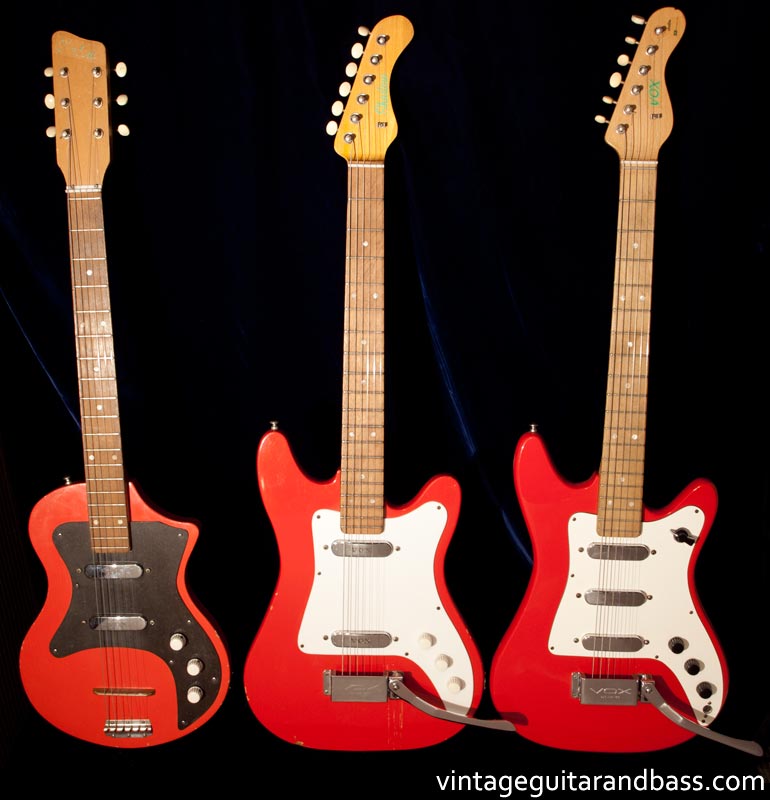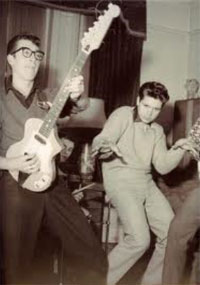

The story of Vox guitars is so often told, not from the beginning, but with the introduction of the Vox Phantom; Vox's first 'original' guitar. But really it starts earlier than that, and is intimately linked with a British guitar band of the period: the Shadows. They not only used Vox amplifiers, they appeared in just about all of Vox's early publicity, and guitarist Hank Marvin even designed a tremolo unit for Vox, fitted to high end solid bodies like the Vox Consort and Vox Phantom.
Under the ownership of JMI (Jennings Musical industries), Vox put out three distinct guitars named Vox Shadow. As eluded to earlier, all early Vox guitars were copies of guitars by other brands, and with some connection to the fore-mentioned Shadows. When the Shadows initially started endorsing Vox amplifiers (1958/59), guitarist Hank Marvin was playing a single cutaway Guyatone LG50 guitar (actually, his was branded Antoria, but otherwise the same). And it was no coincidence that two of the earliest Vox guitars were copies of this: the one-pickup Vox Stroller (after the popular 1950s dance the Stroll), and the two-pickup Vox Shadow.
 Shadows guitarist Hank Marvin with his early Japanese Antoria/Guyatone guitar which inspired the earliest version of the Vox Shadow
Shadows guitarist Hank Marvin with his early Japanese Antoria/Guyatone guitar which inspired the earliest version of the Vox Shadow
These early Voxs were very basic guitars, small and lightweight, with a plywood body, the simplest of tailpieces, a very simple floating bridge and 3 on a plate open gear tuning keys. The scratchplate was simple, just single ply, and the neck had no adjustable truss rod, and no fretboard radius; but perhaps these guitars were not so different from the other guitars available in the UK at this time? They certainly must have appealed to the very many younger Shadows fans in early sixties Britain. Have a closer look at a 1963 LG-50 style Vox Shadow. Note the large scripted Shadow headstock logo.
Currency restrictions in the late 1950s, and comparatively high prices, meant American guitars were not generally imported into the UK. By the early 1960s though, better quality American guitars did start arriving, often with bands returning from US tours, or visiting American artists. These quickly set new standards in what was expected in an instrument. By 1960, Hank Marvin had replaced the Antoria LG50 with a Fiesta red Fender Stratocaster, (the first in the UK, specially imported for him by Cliff Richard) and the early 1960s Shadows sound was in some ways characterised by his use of the Strat with it's tremolo, through a Vox AC15 or AC30. Jennings became the UK distributor of Fender, outfitting the Shadows with Fender guitars, but there was still little chance of younger Shadows fans (or UK guitarists in general) being able to afford the real thing. This lead Vox to create a substitute, upgrading the Stroller and Shadow models with a Stratocaster-styled body and bright red finish. These still had one or two pickups, and a new 'Vox standard' tremolo (have a look at a 1963 Vox Shadow). Finally, the headstock was redesigned to a typical six-in-a-row Stratocaster-style. This version sold well, and is perhaps the most widely seen version of the Shadow. Soon an extra model was added to the line; otherwise identical to the Shadow, but with a third pickup, the Vox Dominator.
Finally, by the middle of 1964, the two-pickup Vox Shadow was renamed the Vox Duotone, and the three-pickup Vox Dominator became the Vox Shadow - have a closer look at a 1964 Vox Shadow. The guitar was improving, and many mid sixties onwards Vox guitars had solid bodies (usually mahogany and agba) rather than laminate. Guitars were being exported to the United States, with export guitars having a 'made in England' label on the reverse of the headstock, or a plaque, usually on the back of the body. Note the black plastic knobs that were usually fitted to these three-pickup models.
The Shadow sold well up until the mid 1960s, with the vast majority in the UK, although many were also exported. Instruments produced for the United States were distributed by the Thomas Organ company. These guitars were typically labelled 'Made in England', either with a circular plate on the reverse of the body, or a sticker on the headstock; they often had upgraded hardware, such as metal control knobs, rather than plastic control knobs and a standard jack input. Production continuing into 1966 and perhaps in small numbers into 1967. Later examples of the Vox Shadow can be characterised by the solid wood body (mahogany) and thicker scratchplate (with wide black edge).
The Shadow had a UK model reference number 234, although the Thomas Organ company gave it a code V-2-8, or V208 in the US. Have a look at the 1966 Vox Shadow parts list produced by Thomas Organ for American dealers.
£1006
£568
£313
£310
€298
£146
£130
£130
£130
£60
£60
£60
£30
£30